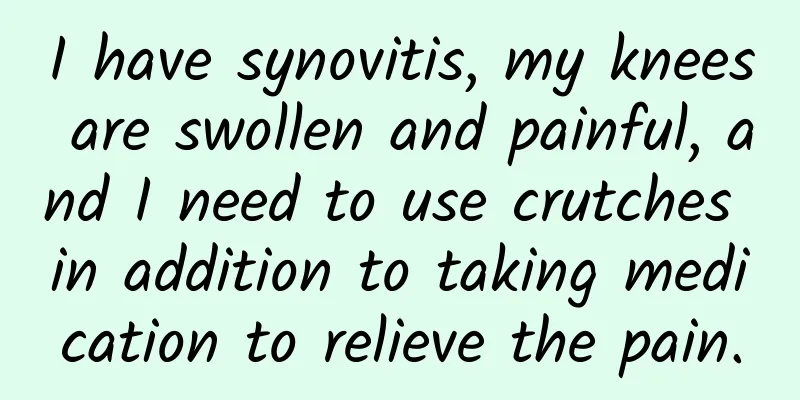I have synovitis, my knees are swollen and painful, and I need to use crutches in addition to taking medication to relieve the pain.

|
Synovitis is a joint disease that often occurs in the knee, hip and other lower limb joints, and manifests as joint swelling, pain and limited mobility. A friend asked Huazi what to do if he has synovitis and how to use medicine? Huazi said that the main function of medicine in the treatment of synovitis is to relieve pain, and the key to curing the disease is to "reduce the burden" on the joints. For example, those who are overweight need to lose weight and use crutches to reduce the weight on the joints and let them heal themselves. 1. What is synovitis? "Synovium" refers to a thin film on the inner surface of the joint capsule, which can secrete synovial fluid to lubricate the joint and provide nutrition and metabolism for tissues such as cartilage and meniscus in the joint. When the synovium is damaged, inflammatory reactions such as redness, swelling, heat, and pain will occur, affecting the normal function of the joint. Among the common factors that cause synovial injury, trauma is the most common, including sprains, collisions, sharp punctures and other factors that cause synovial rupture and congestion, local lymphatic circulation obstruction, effusion, and synovitis. Chronic synovitis caused by excessive weight and long-term strain is also a common cause. Rheumatoid arthritis caused by autoimmune factors; gouty arthritis caused by abnormal uric acid metabolism; intra-articular bleeding caused by coagulation disorders, etc. can all cause synovitis. 2. Examination of synovitis If you experience swelling, pain, local fever, and other symptoms in your joints, you need to seek medical attention. Among imaging examinations such as X-rays, CT scans, and MRIs, MRIs have the best effect, as they can clearly image various tissues such as articular cartilage, ligaments, joint capsules, and menisci, and help you diagnose your condition. At the same time, a routine blood test is required. If the white blood cell count is elevated, it means there is a bacterial infection, and it is necessary to use antibacterial drugs for treatment under the guidance of a doctor. Joint puncture can also be performed to obtain joint fluid for biochemical examination and bacterial culture, which can obtain a more accurate diagnosis. Or, an arthroscope can be used to directly observe the lesion site and degree of damage inside the joint, remove samples of lesion tissue, and perform pathological examination. Treatment of synovitis For acute synovitis caused by traumatic factors, mild injuries generally do not require medication, and the key to treatment is "nurturing". It is recommended to rest in bed for 3 weeks, elevate the affected limb, reduce joint activity, and promote joint recovery. For chronic synovitis caused by overweight and long-term strain, while getting enough rest, you should also lose weight and use crutches to reduce the burden on the joints. For synovial injuries caused by rheumatoid arthritis, gout, coagulation disorders and other factors, the primary disease needs to be treated on the basis of adequate rest. It should be noted that most synovitis is sterile and does not require the use of antibiotics (commonly known as "anti-inflammatory drugs" by the general public). Antibiotics can only be used under the guidance of a doctor if bacterial infection is confirmed. If the pain is obvious, you can consider using topical nonsteroidal anti-inflammatory drugs for pain relief, such as diclofenac cream, compound salicylic acid patch, etc., but be careful not to use it on broken skin. Long-term oral nonsteroidal anti-inflammatory drugs have the risk of causing digestive tract damage, so it is not recommended to use them on your own. Oral medications can only be used under the guidance of a doctor when necessary. If joint movement is severely restricted, drugs such as glucocorticoids and sodium hyaluronate can be injected into the joint cavity to increase joint lubrication and anti-inflammatory effects, which can quickly improve joint function and relieve pain. However, this method is invasive and increases the risk of infection, and requires an experienced doctor to handle it. If the symptoms of joint swelling and pain cannot be relieved after more than 2 months, surgical treatment is recommended. To sum up, the common factors leading to synovitis are acute injury and long-term strain. The treatment method is mainly rest, supplemented by drug pain relief. People who are overweight need to lose weight and use crutches for daily activities to reduce joint pressure. If synovitis is caused by other diseases, the treatment of the primary disease is the main focus. Specific treatment measures and medication need to be carried out under the guidance of a doctor. If you have any questions about medication, consult a doctor or pharmacist in time. I am pharmacist Huazi, welcome to follow me and share more health knowledge. |
>>: How to choose mooncakes for Mid-Autumn Festival? Five things to know about eating mooncakes
Recommend
Why is my private part painful and itchy?
I believe many people know that due to the develo...
How long does it take to cure vaginitis?
A woman's vagina should be maintained in an a...
Can I keep the baby if I do CT during pregnancy?
Many women will try to keep fit during pregnancy ...
Picture of embryo transfer on the fourth day
As we all know, in vitro fertilization helps wome...
How should I treat abdominal pain during menstruation?
Women generally feel a little uncomfortable durin...
What suppository is best for cervical erosion?
For many women, it is easier to suffer from some ...
Is growing taller painful? Uncovering the "little episodes" in the process of children growing taller →
Spring is the season of revival and the "gol...
Disadvantages of eating soy products for women
Tofu not only contains eight essential amino acid...
Benefits of Women's Multivitamin Tablets
In modern society, market competition is fierce, ...
Can I eat sea cucumbers during late pregnancy?
Sea cucumber is a seafood with relatively high nu...
Precautions for pregnancy postures
Assisted pregnancy is a complicated process and t...
How long does a laparotomy take?
Caesarean section is a necessary surgery for givi...
Can I drink milk tea when my period comes?
Girls should pay attention to a light diet during...
Are roasted oranges effective in treating coughs?
"Have you ever eaten roasted oranges? I hear...
Female urethra length and catheterization
Catheterization for female patients: The female u...









